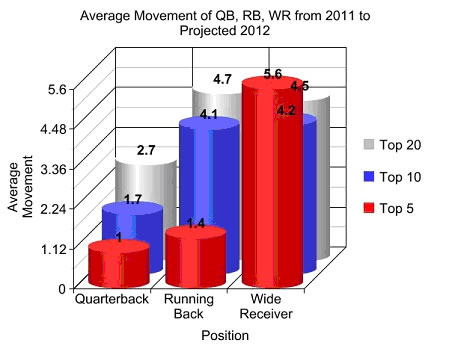Jonathan Bales is the founder of TheDCTimes.com
and writes for the New York Times and Dallas Cowboys. He’s
the author of Fantasy
Football for Smart People: How to Dominate Your Draft.
The importance of the quarterback position to fantasy owners has
increased substantially over the past few years, and for good reason.
Quarterback play is generally very consistent, particularly near
the top of the draft. I recently took a look at the projected movement
in 2012 fantasy rank from the 2011 standings for quarterbacks, running
backs, and wide receivers.

Note that I didn’t use subjective values for the projections;
I used a regression of 2011 stats similar to what I did in my wide
receiver projections and tight
end projections here at FF Today. The graph displays how many
spots players at each position are projected to move in 2012 based
on this regression analysis. Taking a look back at historical rankings,
past data mirrors what you see above.
There is a ton of interesting information in the graph, but perhaps
most intriguing is the incredible consistency of quarterbacks. The
top five quarterbacks from 2011 are projected to move just a single
spot in the rankings after all is said and done this season. Similar
consistency is seen among the elite running backs, but nowhere else.
You can see the predictability of the running back position tails
off, while quarterbacks remain steady. The top 20 quarterbacks from
2011 are projected to move only 2.7 spots, on average, in the 2012
rankings—talk about consistency.
For fantasy owners, I think this is solid
evidence that you should be targeting a top-tier running back or
quarterback in the first round. Calvin Johnson is an outstanding
weapon, but he’s probably more likely to end up seventh in
fantasy points in 2012 than repeating his first place finish from
last season. The wide receiver position is simply too volatile,
and thus unpredictable, to be given much consideration early in
the draft.
A lot of owners might look at the consistency of second and even
third-tier quarterbacks as a reason to wait on drafting one, but
I disagree. Yeah, you know what you’re getting when you draft
a player like Matt Ryan or Ben Roethlisberger, but your goal in
the middle rounds isn’t all about minimizing risk. Actually,
you should search for players who possess great upside without abnormally
low floors. In selecting a middle-tier quarterback, you’re
unnecessarily limiting the upside of your team.
In my book Fantasy
Football for Smart People, I talk a lot about why volatility
isn’t always a bad thing. In the early rounds, you want to
minimize volatility because players’ ceilings are reflected
in their draft spot. The top picks are the outliers from previous
seasons, meaning they don’t possess much upside relative to
their draft slot.
If you have the top overall pick, for example, the best you can
hope for is getting what you paid for. The return on investment,
due to the price of the pick, is inherently minimal. With the upside
of players built into the cost of the draft slot, owners would be
prudent to minimize downside early in the draft, i.e. select safe,
consistent players. No one is as consistent as a quarterback.
In the middle and late rounds, volatility can be utilized to increase
a team’s upside. As the draft progresses, your draft strategy
should shift as well, emphasizing players with high ceilings over
“safe” picks. Thus, while quarterbacks 10-20 are highly
consistent, that’s not a great reason to select them. Actually,
it may be a reason to grab a quarterback early and bypass the safety
of a mid-round quarterback.
Whereas plenty of second and third-tier running backs and receivers
jump into the top 10 and even top five in any given season, it’s
rare for a quarterback to do it. Even though quarterback depth in
the middle rounds is great, landing a top-tier passer may be prudent
this season. Position scarcity is a big reason. An amazing degree
of consistency is a better one.
Ultimately, though, your draft strategy should be flexible and multi-dimensional.
Drafting near the top of the first round, you should be looking
at the top-end running backs, targeting Drew Brees or Cam Newton
on the way back in the second round. On the other hand, Tom Brady
(or Brees) might be an option with one of your first two picks if
you hold a draft slot near the bottom of the first round.
In my next post, I will break down the consistency of each individual
quarterback statistic, detailing which stats should be weighted
most heavily in your projections this season.
|

